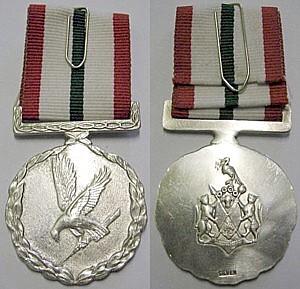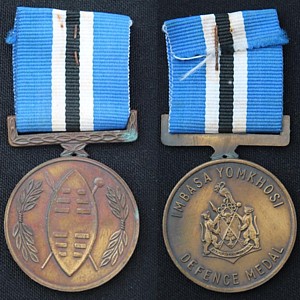
The iPhrothiya yeBhronzi - Bronze Protea, post-nominal letters PB, was instituted by the President of the Republic of South Africa on 16 April 2003 and came into effect on 27 April 2003. It can be awarded to all ranks who have distinguished themselves by leadership or meritorious service and devotion to duty.

The Military Rule Medal was instituted by the State President of the Republic of Transkei to commemorate the bloodless 1987 military coup d'état which overthrew the Transkei government on 30 November 1987.

The Korea Medal is a military campaign medal which was instituted by the Union of South Africa in 1953. It was awarded to volunteers of the Union Defence Forces for service in Korea during the 1950-1953 Korean War.

The Pro Virtute Decoration, post-nominal letters PVD, is a military decoration for bravery which was instituted by the Republic of South Africa in 1987. It was awarded to officers of the South African Defence Force for distinguished conduct and exceptional leadership during combat operations in the field.

The Transkei Defence Force Medal was instituted by the State President of the Republic of Transkei for award to all ranks as a military medal for merit.

The Cross for Bravery was instituted by the State President of the Republic of Transkei, for award to all ranks as a decoration for bravery.

The Marumo Medal, Class I was instituted by the State President of the Republic of Bophuthatswana in 1988.

The Defence Force Merit Medal was instituted by the State President of the Republic of Bophuthatswana in 1982, for award to all ranks for extraordinarily excellent service and particular devotion to duty.

The Defence Force Merit Decoration was instituted by the State President of the Republic of Bophuthatswana in 1982, for award to officers for distinguished service of high quality and utmost devotion to duty.

The Sandile Decoration, post-nominal letters SD, was instituted by the President of the Republic of Ciskei in 1988, for award to all ranks for meritorious service.

The Sandile Medal was instituted by the President of the Republic of Ciskei in 1988, for award to all ranks for meritorious service.

The Ciskei Defence Medal was instituted by the President of the Republic of Ciskei in 1988, for award to all ranks for general service.

The Independence Medal was instituted by the President of the Republic of Ciskei in 1981, for award to all serving members of the Ciskei Defence Force on 4 December 1981 to commemorate the independence of Ciskei.

The Medal for Long Service, Bronze was instituted by the President of the Republic of Ciskei in 1988, for award to all ranks for ten years faithful service.

The President's Medal for Shooting was instituted by the President of the Republic of Ciskei in 1988, for award to champion shots.

The Decoration for Merit in Gold, post-nominal letters DMG, was instituted by the President of the Republic of South Africa in April 1996. It was awarded to veteran cadres of uMkhonto we Sizwe, the military wing of the African National Congress, who had distinguished themselves during the "struggle" by outstanding service and utmost devotion to duty.

The Merit Medal in Bronze, post-nominal letters MMB, was instituted by the President of the Republic of South Africa in April 1996. It was awarded to veteran cadres of uMkhonto we Sizwe, the military wing of the African National Congress, who had distinguished themselves during the "struggle" by service of a high order.

The Gold Decoration for Merit, post-nominal letters GDM, was instituted by the President of the Republic of South Africa in April 1996. It was awarded to veteran cadres of the Azanian People's Liberation Army, the military wing of the Pan Africanist Congress, for outstanding service and utmost devotion to duty during the "struggle".

The Silver Medal for Merit, post-nominal letters SMM, was instituted by the President of the Republic of South Africa in April 1996. It was awarded to veteran cadres of the Azanian People's Liberation Army, the military wing of the Pan Africanist Congress, for exceptionally meritorious service and particular devotion to duty during the "struggle".

The Bronze Medal for Merit, post-nominal letters BMM, was instituted by the President of the Republic of South Africa in April 1996. It was awarded to veteran cadres of the Azanian People's Liberation Army, the military wing of the Pan Africanist Congress, for service of a high order during the "struggle".




















